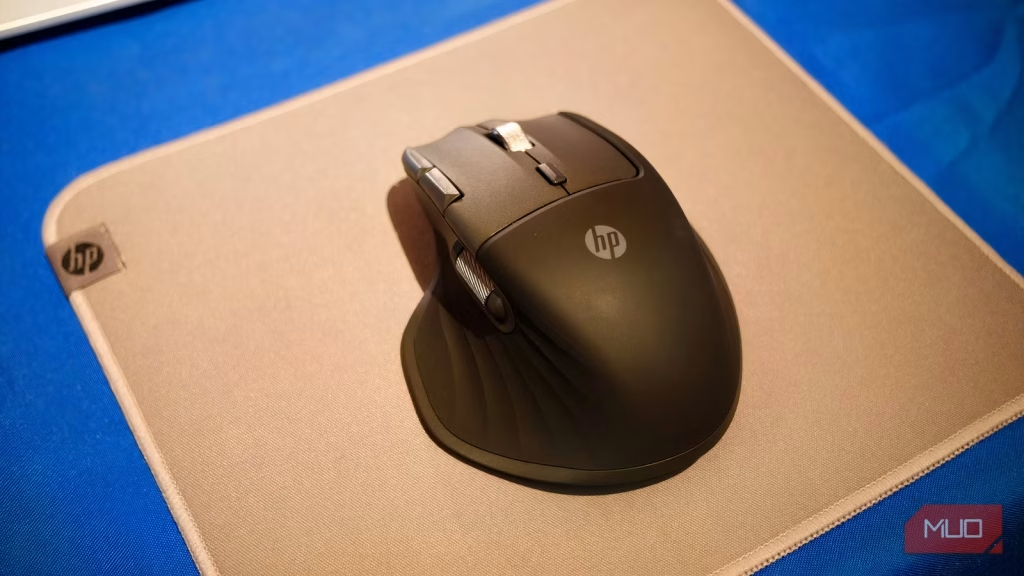Earlier this month, HP debuted a mouse that, at first glance, looks and feels like a real competitor to Logitech’s beloved MX Master series — the long-standing and incredibly popular productivity mouse.
The HP Ultra-Fast Scroll Wireless Mouse 785M, which the company debuted in October and is selling for $80, charges via a USB-C 3.0 port in three minutes and lasts for a month of work between charges.
When using it this week at a media event, I could only think of how it might soon replace my well-used Logitech MX Master 3.
This mouse charges in 3 minutes and runs for a month
Beacuse it has a supercapacitor instead of a battery
Thanks to a supercapacitor, this new HP mouse can charge in just 180 seconds and last for four weeks. On the outside, it features six programmable buttons, two metal scroll wheels that are cool to the touch, customizable speed settings, and a comfy silicone shell.
The 785M weighs just .28 pounds and measures 4.88 x 3.93 x 1.79 inches. The mouse isn’t quite out yet — it’s up for pre-order and ships on November 14, according to the HP website.
Credit: Nick Lucchesi/MakeUseOf
Kevin Wentzel, a Product Experience Strategist at HP, explains the incredible three-minute charging stat this way to MakeUseOf: “The capacitor is able to charge very, very fast relative to a battery,” Wentzel said at the Pepcom technology event this week in New York.
Just recently, we’ve seen a lot more of these super capacitors being used as power storage in devices, especially something like this mouse.
“And with that charge, you can run for a long time without a recharge. Capacitors have been used for quite a while, but just recently, we’ve seen a lot more of these super capacitors being used as power storage in devices, especially something like in this mouse.
Why HP ditched batteries for supercapacitors
Batteries charge slowly; supercapacitors don’t
An HP blog post from February makes the case: “Traditional batteries rely on chemical reactions to store and release energy. This process degrades the internal components over time, typically limiting devices to 500-1,000 charge cycles before performance drops significantly. Supercapacitors (also called ultracapacitors or EDLCs) store energy by physically separating electrical charges rather than through chemical reactions.”
The result is a faster charge, up to ten times more charge cycles, better resilience to extreme temperatures that regular batteries might suffer under, and no degradation over time, unlike batteries.
Supercapacitor technology is improving and thanks to a regulated charging current courtesy of a USB-C cable, going over voltage and damaging the supercapacitor is highly unlikely.
When asked about competition with Logitech, Wentzel had this to say: “Really, all I will say is it’s a fantastic HP mouse. It has a really cool feature in fast charging.”
Credit: HP
Weight
0.28 lb
Dimensions
4.88 x 3.93 x 1.79 in
The HP Ultra-Fast Scroll Wireless Mouse 780M is a productivity-focused mouse featuring dual metal scroll wheels for vertical and horizontal navigation, six programmable buttons, and multi-device connectivity via Bluetooth 5.3 or a 2.4 GHz USB-A receiver. It uses a supercapacitor instead of a battery, charging fully in three minutes and lasting up to 30 days on a single charge.
Can HP’s new mouse dethrone the MX Master 4?
If HP wants to win the mouse wars against Logitech, it has its work cut out for it. After years of success with the beloved Logitech MX Master 3 mouse, the company released the MX Master 4 mouse at the end of September, to more positive reviews. We were blown away by the MX Master 4 mouse’s Actions Ring feature.
No one will confuse either of these devices for a gaming mouse, but just calling them “enterprise” devices undersells their mass appeal.
No one will confuse either of these devices for a gaming mouse, but just calling them “enterprise” devices undersells their mass appeal. Logitech mice are, in reality, just about the best computer mice you can buy for their programming options, comfort, longevity, durability, and consistency.
The MX Master series will be challenging to beat, but with its familiar design and innovative supercapacitor charging, HP seems to be making an admirable effort.


